Delhi often referred to as a historical and cultural treasure trove, boasts an array of iconic Historical Places in Delhi. As the vibrant capital city of India, Delhi is a living testament to the rich heritage of the Indian subcontinent.
With its roots deeply embedded in centuries of tradition and marked by the footprints of numerous dynasties, the city’s historical sites offer a captivating glimpse into India’s past.
In this blog, we embark on a journey to explore the top 10 Historical Places in Delhi, each of which plays a significant role in narrating the city’s storied history.
These sites not only stand as monuments but also serve as gateways to different epochs, where the echoes of history resound through every stone, and the essence of bygone eras lingers in the air.
Our exploration of these Historical Places in Delhi is not just about rediscovering the past; it is also a tribute to the importance of historical tourism in preserving our cultural heritage.
By immersing ourselves in the stories etched into Delhi’s monuments and artifacts, we actively contribute to the protection and conservation of these invaluable treasures, ensuring they endure for generations to come.
Top 10 Historical Places in Delhi For Delhi Darshan
If you’re planning a Delhi Darshan, exploring the historical places in Delhi is a must. Delhi boasts a rich tapestry of history, and its historical sites offer a glimpse into the city’s past. Let’s delve into some of these remarkable historical places for an enriching Delhi Darshan.
1. Red Fort (Lal Qila) – Historical Places In Delhi
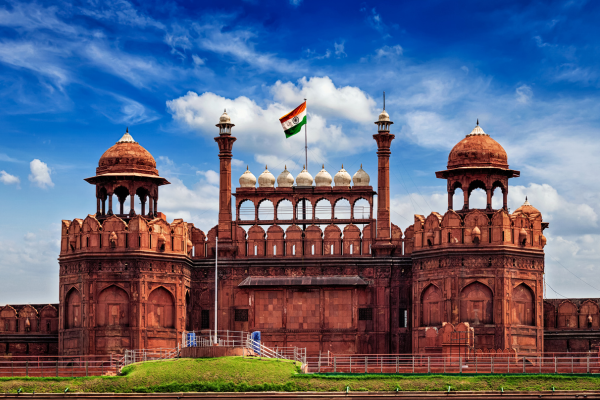
The Red Fort, or Lal Qila, is an iconic symbol of India’s rich history and struggle for independence. This majestic fort was constructed during the Mughal era, primarily commissioned by Emperor Shah Jahan. Its historical importance lies in its role as the main residence of Mughal emperors for around 200 years.
The fort complex covers a vast area and includes several impressive buildings, such as the Diwan-i-Aam (Hall of Public Audience), Diwan-i-Khas (Hall of Private Audience), the Moti Masjid (Pearl Mosque), and the iconic Lahori Gate.
It is also renowned for hosting India’s Independence Day celebration on August 15th, when the Prime Minister hoists the national flag and addresses the nation from the Red Fort’s ramparts.
Built By: The Red Fort was built by the Mughal Emperor Shah Jahan. Construction of the fort began in 1638, and it took approximately a decade to complete. The fort served as the main residence of the Mughal emperors for about 200 years.
Built In: The construction of the Red Fort started in 1638, and it was completed in 1648. It was constructed using red sandstone and showcased an exquisite Mughal architectural style.
Location
The Red Fort, also known as “Lal Qila” in Hindi, stands at the heart of Old Delhi. You can find it at Netaji Subhash Marg, Lal Qila, Chandni Chowk, New Delhi, Delhi 110006, India.
Best Time to Visit
For an enjoyable visit to the Red Fort, plan your trip during the cooler months, which typically span from October to March. During this period, the weather is more pleasant and conducive to outdoor exploration. It’s also advisable to visit either early in the morning or late in the afternoon to avoid the scorching midday heat and large crowds.
Timings
The Red Fort welcomes visitors from Tuesday to Sunday. The operational hours are between 9:30 AM and 4:30 PM. It’s worth noting that the fort remains closed on Mondays.
Entry Fees
The entry fees for the Red Fort are as follows:
- For Indian citizens, the admission fee is INR 35 per person.
- Foreign tourists are charged INR 500 per person.
- Children under the age of 15 enjoy free entry.
Nearest Metro Station
The most convenient metro station for reaching the Red Fort is the “Chandni Chowk Metro Station,” which belongs to Delhi Metro’s Yellow Line. From the metro station, it’s just a short walk to the entrance of the Red Fort.
Highlights and Must-See Attractions:
- The Diwan-i-Aam: This grand hall was where the emperor addressed the general public and heard their grievances.
- The Diwan-i-Khas: An intricately designed hall reserved for private audiences with the emperor.
- The Moti Masjid: A pristine white marble mosque within the fort complex.
- Sound and Light Show: In the evenings, the Red Fort hosts a captivating sound and light show that narrates the fort’s history.
Visitor Tips
- Dress comfortably and wear suitable walking shoes, as you’ll be exploring a vast area.
- Carry drinking water to stay hydrated, especially during the hot months.
- Bring your camera to capture the fort’s stunning architecture.
- Show respect for the historical significance of the site and follow any guidelines or instructions provided by the authorities.
Please note that the entry fees and other details may be changed, so it’s advisable to check the latest information before planning your visit to the Red Fort in Delhi.
Also Read: Alleppey Backwater Ride (Alappuzha): Explore the Nature Beauty
Other Monuments Near Red Fort (Lal Qila):
Jama Masjid: Located just opposite the Red Fort, the Jama Masjid is one of the largest mosques in India. It was also built by Emperor Shah Jahan and is a fine example of Mughal architecture.
1. Chandni Chowk: This bustling market area is one of the oldest and busiest in Delhi. It offers a wide range of street food, shopping, and cultural experiences.
2. Salimgarh Fort: Situated on an island on the Yamuna River, this fort is adjacent to the Red Fort. It was built by Emperor Islam Shah Suri in 1546 and has a rich history.
Top Things to Do Nearby Red Fort (Lal Qila):
1. Explore the Red Fort: Start by exploring the Red Fort itself, including its impressive architecture, Diwan-i-Aam (Hall of Public Audience), Diwan-i-Khas (Hall of Private Audience), and the beautiful Rang Mahal.
2. Visit Jama Masjid: Explore the grandeur of the Jama Masjid and take in the panoramic views of Delhi from its minarets.
3. Shop and Eat at Chandni Chowk: Wander through the bustling lanes of Chandni Chowk, where you can shop for traditional Indian goods and savor delicious street food.
4. Attend the Light and Sound Show: The Red Fort hosts an evening light and sound show that narrates the history of Delhi and the Mughal Empire. It’s a captivating experience.
5. Stroll Along the Yamuna River: If you have time, take a leisurely walk along the banks of the Yamuna River, where you can enjoy scenic views and serene surroundings.
6. Explore Salimgarh Fort: While not as well-known as the Red Fort, Salimgarh Fort offers an intriguing historical experience and lovely river views.
7. Attend Cultural Events: Check if there are any cultural events or festivals happening in the vicinity, as this area often hosts various celebrations.
Visiting the Red Fort and its surrounding monuments is not only a historical journey but also an opportunity to immerse yourself in the rich cultural heritage of Delhi, that’s why it is among Top 10 Historical Places in Delhi.
You may also like to read: Discover the 7 Best Places to Visit During Navratri Festival
2. Qutub Minar – Historical Places In Delhi
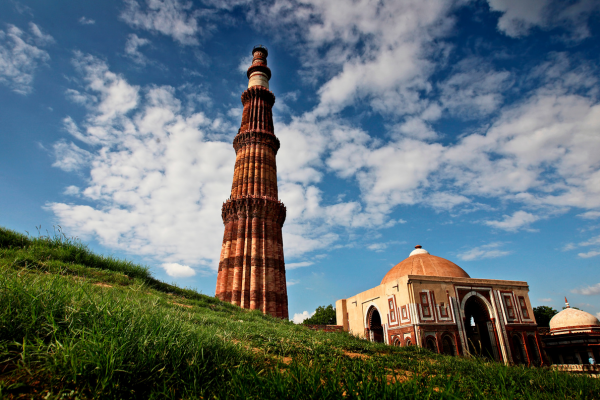
Among the plethora of historical places in Delhi, one iconic monument stands tall, quite literally, as a testament to the city’s rich heritage and architectural grandeur: the Qutub Minar. Located in the Mehrauli area of South Delhi, this UNESCO World Heritage Site is a towering marvel that draws visitors from across the globe.
History of Qutub Minar:
Built By: Qutub Minar was built by Qutb-ud-din Aibak, the founder of the Delhi Sultanate. It was later expanded by his successors, including Iltutmish and Firoz Shah Tughlaq.
Built In: The construction of Qutub Minar began in 1192 AD and was completed in 1220 AD during the reign of Iltutmish. It is located in the Mehrauli area of Delhi, India.
Location
Qutub Minar, a prominent landmark among Delhi’s Historical Places, is situated in the Mehrauli area of South Delhi. Its precise address is Aurobindo Marg, Mehrauli, New Delhi, Delhi 110030, India.
Best Time to Visit
The best time to explore Qutub Minar is during the cooler months, typically from October to March. This period offers pleasant weather for outdoor exploration, making your visit more enjoyable.
Timing
Qutub Minar is open to visitors from Tuesday to Sunday. You can visit between 7:00 AM and 5:00 PM. Similar to many historical sites, it is closed on Mondays.
Entry Fees
The entry fees for Qutub Minar are as follows:
- For Indian citizens: INR 40 per person.
- For foreign tourists: INR 600 per person.
- Free for children under the age of 15.
Nearest Metro Station
The nearest metro station to Qutub Minar is “Qutub Minar Metro Station,” which is part of Delhi Metro’s Yellow Line.
Highlights and Must-See Attractions
- The Qutub Complex: Besides the main minaret, the Qutub Complex houses several other historical structures, including the Quwwat-ul-Islam Mosque, Alai Darwaza, and the Iron Pillar of Delhi.
- The Iron Pillar: This remarkable iron pillar, known for its rust-resistant composition, has stood the test of time for over 1,600 years.
- Intricate Carvings: The walls of the complex are adorned with intricate inscriptions and decorative motifs, reflecting the craftsmanship of the time.
- Quwwat-ul-Islam Mosque: One of the earliest mosques built in India, it’s an architectural marvel with a rich history.
Visitor Tips
- Wear comfortable footwear suitable for walking, as the complex covers a significant area.
- Don’t forget to carry drinking water, especially during the warmer months.
- Bring your camera to capture the intricate details of the monument and the picturesque surroundings.
- Show respect for the historical significance of the site and follow any guidelines or instructions provided by the authorities.
Qutub Minar, nestled in the Historical Places in Delhi, offers a glimpse into the city’s glorious past. It’s a testament to the architectural prowess of its time and a must-visit destination for history enthusiasts and travelers alike.
Please verify the entry fees and any updates to visiting hours before planning your visit to ensure a seamless experience.
Other Monuments Near Qutub Minar:
1. Iron Pillar of Delhi: Located in the Qutb complex, this ancient iron pillar dates back to the 4th century and is known for its remarkable rust-resistant properties.
2. Alai Darwaza: This grand gateway was built by Alauddin Khalji and serves as an entrance to the Qutb complex. It is adorned with intricate Islamic architectural details.
3. Quwwat-ul-Islam Mosque: One of the earliest mosques built in India, it is situated within the Qutb complex and is known for its unique blend of Hindu and Islamic architectural elements.
4. Tomb of Iltutmish: This mausoleum is the final resting place of Iltutmish, the second Sultan of Delhi from the Mamluk dynasty.
5. Tomb of Imam Zamin: A beautiful octagonal tomb located near the Qutb Minar.
Top Things to Do Nearby Qutub Minar:
1. Explore the Qutb Complex: Spend time exploring the Qutb Minar complex, which includes various historical structures, intricate carvings, and ruins that offer insights into India’s rich history.
2. Photography: Qutub Minar and its surroundings provide excellent opportunities for photography, especially during different times of the day.
3. Attend Light and Sound Show: The Qutb Minar complex often hosts an evening light and sound show that narrates the history of the monument in an engaging way.
4. Visit Mehrauli Archaeological Park: This park is located nearby and is home to several historical structures, including stepwells, tombs, and a medieval-era village.
5. Shopping: Explore the nearby markets and shops for traditional Indian handicrafts, jewelry, and textiles.
6. Culinary Exploration: Enjoy local Indian cuisine at the numerous restaurants and eateries in the vicinity of Qutub Minar.
7. Relax in Lush Gardens: The Qutb complex features beautiful gardens and green spaces where you can relax and enjoy the serene ambiance.
Visiting Qutub Minar and its surroundings is not only a journey through history but also an opportunity to appreciate the architectural and cultural diversity of India, that’s why it is among Top 10 Historical Places in Delhi.
Also Read: 30 Spiritual and Religious Places in India
3. Humayun’s Tomb – Historical Places In Delhi
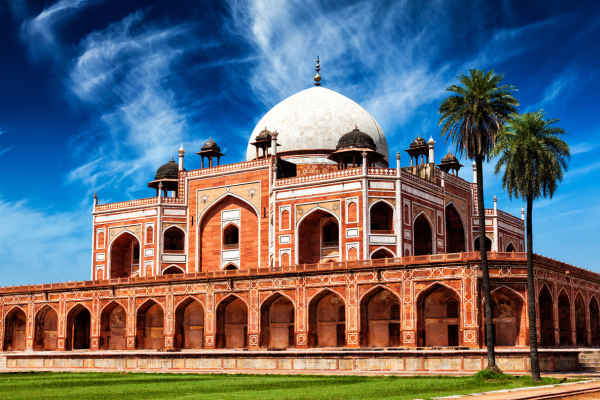
Humayun’s Tomb, a UNESCO World Heritage Site, is a stunning architectural masterpiece that pays tribute to Mughal Emperor Humayun. Built in the mid-16th century, it serves as a precursor to the renowned Taj Mahal and showcases the fusion of Persian and Indian architectural styles.
History of Humayun’s Tomb:
The Qutub Minar is a historical monument located in Delhi, India. It is a UNESCO World Heritage Site and a symbol of India’s rich architectural and cultural heritage. The construction of the Qutub Minar began in the early 13th century and was completed by different rulers over the centuries.
Built By: The Qutub Minar was initiated by Qutb-ud-din Aibak, the founder of the Delhi Sultanate, and later completed by his successors, including Iltutmish and Firoz Shah Tughlaq.
Built In: The construction of the Qutub Minar started in 1192 AD and continued through the 13th and 14th centuries.
Location
Nestled in the heart of Delhi, Humayun’s Tomb stands as a timeless testament to architectural excellence among the many Historical Places in Delhi. You can find this exquisite monument at Mathura Road, Nizamuddin East, New Delhi, Delhi 110013, India.
Best Time to Visit
To fully appreciate the splendor of Humayun’s Tomb, plan your visit during the cooler months, typically from October to March. The pleasant weather during this period enhances your exploration experience.
Timing
Humayun’s Tomb welcomes visitors from Tuesday to Sunday, with operating hours from 8:00 AM to 6:00 PM. It is closed on Mondays.
Entry Fees
The entry fees for Humayun’s Tomb are as follows:
- For Indian citizens: INR 30 per person.
- For foreign tourists: INR 500 per person.
- Children under the age of 15 receive free admission.
Nearest Metro Station
The nearest metro station to Humayun’s Tomb is “JLN Stadium Metro Station,” which is part of Delhi Metro’s Violet Line. From the metro station, it’s a short commute to the monument.
Highlights and Must-See Attractions
- The Tomb and Garden: The central tomb is a symmetrical marvel, surrounded by lush Mughal-style gardens, water channels, and fountains, creating a serene and picturesque setting.
- Chhatri and Barber’s Tomb: Within the complex, you’ll find smaller tombs and structures, including the Chhatri of Isa Khan and the Barber’s Tomb.
- The Char Bagh Garden: Modelled after the Persian-style gardens, the Char Bagh is a quadrilateral garden divided into four parts by water channels. It offers a perfect spot for relaxation and photography.
- Mughal Architecture: The intricate details, Persian calligraphy, and architectural finesse of Humayun’s Tomb make it a treasure trove of Mughal design.
Visitor Tips
- Wear comfortable shoes suitable for exploring the gardens and pathways within the complex.
- Carry drinking water to stay hydrated, especially during the warmer months.
- Bring your camera to capture the exquisite architectural details and the tranquil beauty of the gardens.
- Show respect for the historical significance of the site by refraining from touching or defacing the monuments.
Other Monuments Near Humayun’s Tomb:
- Iron Pillar of Delhi: The Iron Pillar of Delhi is a remarkable 7-meter-high iron pillar that stands in the Qutub Minar complex. It is known for its exceptional rust resistance, even after more than a thousand years.
- Alai Darwaza: Alai Darwaza is a magnificent entrance gate made of red sandstone and white marble. It stands as a grand example of Indo-Muslim architecture.
- Alai Minar: The Alai Minar is an unfinished tower located near the Qutub Minar. It was intended to be a taller and grander version of the Qutub Minar but was left incomplete.
Top Things to Do Nearby Humayun’s Tomb:
- Humayun’s Tomb: Visit the beautiful Mughal-era tomb of Emperor Humayun, another UNESCO World Heritage Site, known for its stunning architecture and lush gardens.
- Lotus Temple: Explore the Bahá’í House of Worship, often called the Lotus Temple due to its distinctive lotus flower-like shape, which is open to people of all faiths.
- India Gate: Pay your respects at the iconic India Gate war memorial, dedicated to the soldiers who died in World War I.
- Red Fort: Discover the Red Fort, a historic fort complex that served as the main residence of the Mughal emperors for centuries.
- Jama Masjid: Visit India’s largest mosque, the Jama Masjid, known for its grand architecture and spiritual significance.
- Chandni Chowk: Explore the bustling markets and narrow lanes of Chandni Chowk, offering a glimpse into Delhi’s vibrant street culture and delicious street food.
- Akshardham Temple: Experience the grandeur of the Akshardham Temple, a modern marvel of Indian architecture and spirituality.
A visit to Humayun’s Tomb offers not only a glimpse into India’s rich history but also a serene escape from the hustle and bustle of Delhi. As you explore this architectural marvel, you become part of the legacy of Delhi’s Historical Places, contributing to their preservation for generations to come, that’s why it is among the Top 10 Historical Places in Delhi.
Also Read: 10 Best Places to Visit in Dussehra: Where and How to Celebrate
4. Purana Qila, Delhi – Historical Places In Delhi
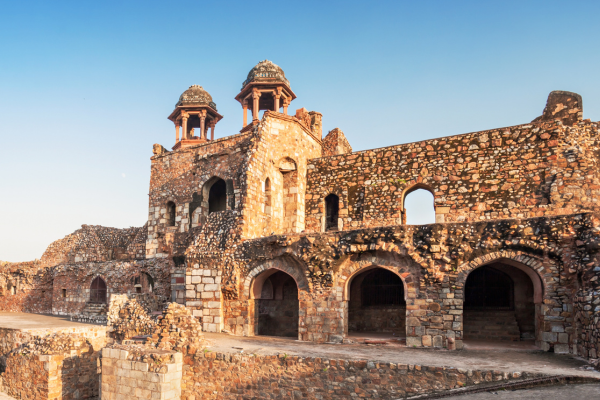
Purana Qila, translating to “Old Fort,” is a historical gem that dates back to the 16th century during the reign of the Mughal Emperor Humayun. It showcases a synthesis of architectural styles, blending elements of the Afghan and Indian traditions. This fort, perched near the Yamuna River, is known for its imposing walls and monumental gateways.
History of Purana Qila:
Purana Qila, also known as the Old Fort, is one of the oldest forts in Delhi, with a history dating back to ancient times. It has witnessed several historical events and rulers over the centuries.
Built By: Purana Qila was initially built by the Pandavas of the Mahabharata, according to legend. However, the present structure was primarily constructed by the Mughal Emperor Sher Shah Suri in the mid-16th century.
Built In: The construction of Purana Qila took place during the 16th century, with Sher Shah Suri overseeing its development. Later, it was renovated and modified during the Mughal period.
Location
Purana Qila, also known as Old Fort, stands as a silent sentinel to history’s whispers among the distinguished Historical Places in Delhi. This magnificent fort is located at Mathura Road, near the Delhi Zoo, New Delhi, Delhi 110003, India.
Best Time to Visit
The ideal time to explore Purana Qila is during the months from October to March when the weather is pleasant for outdoor activities. Delhi’s winters offer a comfortable backdrop to dive into history.
Timing
Purana Qila welcomes visitors from Tuesday to Sunday. The fort’s operational hours are from 7:00 AM to 5:00 PM. Please note that it remains closed on Mondays.
Entry Fees
As of my last knowledge update in September 2021, the entry fees for Purana Qila are as follows:
- For Indian citizens: INR 20 per person.
- For foreign tourists: INR 200 per person.
- Free for children under the age of 15.
Nearest Metro Station
The nearest metro station to Purana Qila is “Pragati Maidan Metro Station,” which is part of Delhi Metro’s Blue Line. From there, it’s a short distance to the fort.
Highlights and Must-See Attractions
- Sher Mandal: The Sher Mandal, an octagonal structure within the fort, is believed to have been Humayun’s library and observatory.
- Qila-i-Kuhna Mosque: This elegant mosque stands within the complex and features a stunning facade with ornate embellishments.
- Humayun’s Library: The site also includes a library attributed to Humayun, offering insight into the intellectual pursuits of the era.
- Sound and Light Show: Purana Qila hosts a captivating sound and light show in the evenings, narrating the fort’s history against the backdrop of its majestic architecture.
Visitor Tips
- Wear comfortable footwear suitable for walking and exploring the vast fort complex.
- Carry drinking water to stay hydrated, especially during warmer months.
- Don’t forget your camera to capture the intricate architectural details and the historical ambiance.
- Show respect for the historical significance of the site by refraining from touching or defacing any monuments.
Other Monuments Near Purana Qila:
- Sher Mandal: An octagonal tower inside the fort, where Emperor Humayun fell to his death.
- Qila-i-Kuhna Mosque: A beautiful mosque with impressive Mughal architecture located within the fort complex.
- Sher Shah Gate: The main entrance gate of Purana Qila, named after Emperor Sher Shah Suri.
- National Handicrafts and Handlooms Museum: Located just outside the fort, this museum showcases a wide range of traditional Indian handicrafts and textiles.
Top Things to Do Nearby Purana Qila:
- India Gate: Pay your respects at India Gate, a prominent war memorial dedicated to Indian soldiers who died in World War I.
- Humayun’s Tomb: Visit the stunning Mughal-era tomb of Emperor Humayun, a UNESCO World Heritage Site.
- Qutub Minar: Explore the iconic Qutub Minar and its complex, which houses several historical structures.
- Jama Masjid: Visit the grand Jama Masjid, one of the largest mosques in India, known for its magnificent architecture.
- Lotus Temple: Discover the Bahá’í House of Worship, designed in the shape of a lotus flower and open to people of all faiths.
- Red Fort: Explore the historic Red Fort, another UNESCO World Heritage Site and a symbol of India’s rich history.
- Chandni Chowk: Experience the bustling markets and vibrant street culture of Old Delhi, known for its street food and traditional markets.
Purana Qila, Delhi, is not just a historical site; it’s a journey through time and an essential destination among the Historical Places in Delhi. As you wander through its ancient corridors and contemplate its impressive architecture, you become part of a legacy that bridges the past and the present. Your visit contributes to the preservation of Delhi’s remarkable history for generations to come, that’s why it is among the Top 10 Historical Places in Delhi.
Also Read: 26 Best Winter Tourist Destinations in India for a Relaxing Holiday
5. Lotus Temple (Bahá’í House of Worship) – Historical Places In Delhi
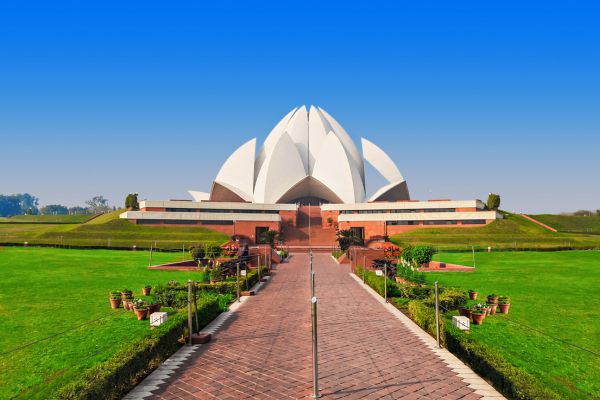
The Lotus Temple, a symbol of unity and tranquility among Historical Places in Delhi, is a Bahá’í House of Worship renowned for its distinctive lotus-shaped architecture. It serves as a place of worship for people of all religions, fostering the message of harmony and oneness.
History of Lotus Temple:
The Lotus Temple, also known as the Bahá’í House of Worship, is a modern architectural marvel located in Delhi, India. It is known for its distinctive lotus flower-like shape and serves as a place of worship for the Bahá’í Faith.
Built By: The Lotus Temple was designed by Iranian architect Fariborz Sahba. The construction was funded by the Bahá’í community and involved numerous engineers and workers.
Built In: The construction of the Lotus Temple began in 1980, and it was officially opened to the public in December 1986.
Location
The Lotus Temple, also known as the Bahá’í House of Worship, graces the landscape of South Delhi. You can find this architectural marvel at Lotus Temple Road, Bahapur, Shambhu Dayal Bagh, Kalkaji, New Delhi, Delhi 110019, India.
Best Time to Visit
The Lotus Temple welcomes visitors throughout the year, but the best time to experience its serenity is during the cooler months, from October to March. The pleasant weather enhances your visit, allowing you to explore the lush gardens surrounding the temple.
Timing
The Lotus Temple generally follows these opening hours:
- Summer (April to September): 9:00 AM to 7:00 PM
- Winter (October to March): 9:00 AM to 5:30 PM
- Please note that the temple remains closed on Mondays.
Entry Fees
- Visiting the Lotus Temple is free of charge for all visitors. The temple’s inclusive ethos welcomes people from all walks of life without any fee.
Nearest Metro Station:
The nearest metro station to the Lotus Temple is “Nehru Place Metro Station,” which is part of Delhi Metro’s Violet Line. It’s a convenient and short ride to reach the temple from the metro station.
Highlights and Must-See Attractions
- The Lotus Architecture: The Lotus Temple’s design resembles a blooming lotus flower, with pristine white marble petals gracefully unfolding. It’s a masterpiece of modern architecture that has won numerous awards for its elegance and innovation.
- Gardens and Ponds: The temple is surrounded by lush green gardens and serene ponds, creating a peaceful oasis amidst the city’s hustle and bustle.
- Prayer and Meditation: Visitors are welcome to enter the temple’s prayer hall, where silent meditation and prayer are encouraged. The serene environment promotes contemplation and inner peace.
- Bahá’í Faith Exhibition: The Information Centre near the temple offers insights into the Bahá’í Faith, its teachings, and its message of unity and equality.
Visitor Tips
- Dress modestly and respectfully when visiting the Lotus Temple, covering your arms and legs.
- Maintain silence within the temple’s prayer hall to respect the meditative atmosphere.
- Photography is allowed outside the temple and in the gardens, but avoid photography inside the prayer hall.
- Enjoy the tranquility of the surroundings and take your time to explore the gardens, which are perfect for a leisurely stroll or quiet reflection.
Other Monuments Near Lotus Temple :
- Qutub Minar: Visit the iconic Qutub Minar, a UNESCO World Heritage Site, known for its historical significance and intricate architecture.
- Humayun’s Tomb: Explore the stunning Mughal-era tomb of Emperor Humayun, another UNESCO World Heritage Site.
- India Gate: Pay your respects at India Gate, a prominent war memorial honoring Indian soldiers who died in World War I.
- Red Fort: Discover the historic Red Fort, a symbol of India’s rich history and a UNESCO World Heritage Site.
- Jama Masjid: Visit the grand Jama Masjid, one of the largest mosques in India, known for its magnificent architecture.
- Akshardham Temple: Experience the architectural and spiritual beauty of the Akshardham Temple complex.
- Chandni Chowk: Immerse yourself in the vibrant markets and street culture of Old Delhi, offering an authentic taste of the city’s traditions.
- Purana Qila: Explore the historical Purana Qila (Old Fort), one of the oldest forts in Delhi, known for its historical significance.
The Lotus Temple, with its unique architectural beauty and inclusive spiritual ethos, stands as a symbol of Delhi’s rich tapestry of Historical Places. It offers a serene escape from the city’s hustle and bustle, inviting visitors to embrace harmony and inner peace. Your visit to this remarkable site contributes to the legacy of unity and spirituality it represents, that’s why it is among the Top 10 Historical Places in Delhi.
Also Read: 40 Best Honeymoon Places in India for a Romantic Trip for Couples
6. Akshardham Temple – Historical Places In Delhi
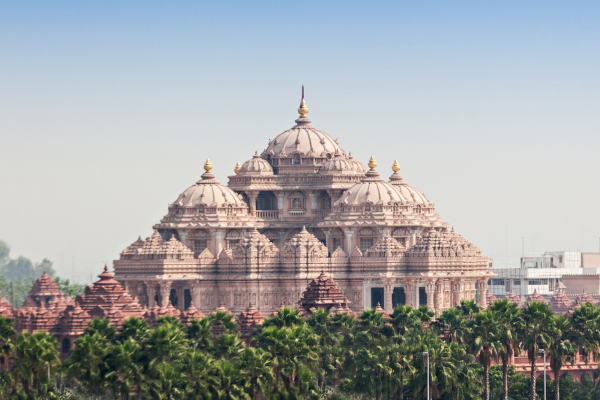
Akshardham Temple, a beacon of spirituality and architectural excellence among Delhi’s Historical Places, is a place where devotion meets artistry. This magnificent temple complex is a modern marvel that celebrates India’s rich cultural heritage while offering a serene sanctuary for spiritual seekers and tourists alike.
It is officially known as the Swaminarayan Akshardham Temple, was opened to the public in 2005. It is dedicated to Bhagwan Swaminarayan and celebrates his teachings and contributions to society. The temple complex is a shining example of modern Indian architecture, combining ancient design principles with contemporary technology.
History of Akshardham Temple:
Akshardham Temple, also known as the Swaminarayan Akshardham Temple, is a relatively modern Hindu temple complex in Delhi, India. It was inaugurated in 2005 and is dedicated to Bhagwan Swaminarayan.
Built By: The Akshardham Temple was built by the Bochasanwasi Shri Akshar Purushottam Swaminarayan Sanstha (BAPS) organization, with Pramukh Swami Maharaj leading the construction efforts.
Built In: The temple complex was inaugurated on November 6, 2005, after several years of construction.
Location
Akshardham Temple is located in the eastern part of Delhi, near the banks of the Yamuna River. Its precise address is Noida Mor, Pandav Nagar, New Delhi, Delhi 110092, India.
Best Time to Visit
The best time to explore Akshardham Temple is during the cooler months, typically from October to March. The pleasant weather enhances the overall experience of visiting this grand complex.
Timing
Akshardham Temple is open to visitors from Tuesday to Sunday, with operational hours from 10:00 AM to 6:30 PM. It remains closed on Mondays.
Entry Fees
As of my last knowledge update in September 2021, the entry fees for Akshardham Temple are as follows:
- Entry to the temple complex is free.
- However, an entry fee is charged for the exhibitions, musical fountain, and boat ride.
- The exhibition fee is ₹250 for adults (12 years and above), ₹200 for senior citizens (60 years and above), and ₹150 for children (4 to 11 years).
- The musical fountain ticket price is ₹80 per person for adults and ₹50 for children between the age group of 4-11 years.
- The boat ride ticket price is within the ticket cost of exhibition shows, which is ₹170 per person for adults, ₹125 for visitors above the age of 60 years, and ₹100 for children aged 4 to 11 years.
Nearest Metro Station
The nearest metro station to Akshardham Temple is “Akshardham Metro Station,” which is part of Delhi Metro’s Blue Line. It’s a short walk from the metro station to the temple entrance.
Highlights and Must-See Attractions
- Akshardham Mandir: The central temple, known as the Akshardham Mandir, is a breathtaking structure built entirely without steel. It is adorned with intricate carvings and sculptures that narrate stories from Indian mythology.
- Yagnapurush Kund: This stunning stepwell and musical fountain is a sight to behold, especially during the evening shows when it comes alive with music, lights, and water displays.
- Exhibitions: Akshardham features several exhibitions that offer immersive experiences, including the Sahaj Anand Water Show and the Yagnapurush Kund Water Show, which provide insights into India’s cultural and spiritual heritage.
- Abhishek Mandap: Visitors can participate in the Abhishek, a Vedic ritual, by pouring holy water and performing offerings to the deities.
- Garden of India: The temple complex also includes beautifully landscaped gardens with sculptures depicting India’s diverse culture and heritage.
Visitor Tips
- Dress modestly when visiting the temple complex, covering your shoulders and knees.
- Photography is restricted within the temple, so be mindful of the rules.
- Check the schedule for the evening musical fountain shows and exhibitions to plan your visit accordingly.
- Maintain silence and respect the spiritual ambiance within the temple premises.
- Be prepared for security checks at the entrance, which are in place to ensure the safety of all visitors.
Other Monuments Near Akshardham Temple:
- Qutub Minar: Visit the iconic Qutub Minar, a UNESCO World Heritage Site known for its historical significance and intricate architecture.
- Humayun’s Tomb: Explore the stunning Mughal-era tomb of Emperor Humayun, another UNESCO World Heritage Site.
- India Gate: Pay your respects at India Gate, a prominent war memorial honoring Indian soldiers who died in World War I.
- Red Fort: Discover the historic Red Fort, a symbol of India’s rich history and a UNESCO World Heritage Site.
- Jama Masjid: Visit the grand Jama Masjid, one of the largest mosques in India, known for its magnificent architecture.
- Lotus Temple: Explore the Bahá’í House of Worship, known for its unique lotus-shaped architecture and spiritual ambiance.
- Chandni Chowk: Immerse yourself in the vibrant markets and street culture of Old Delhi, offering an authentic taste of the city’s traditions.
- Purana Qila: Explore the historical Purana Qila (Old Fort), one of the oldest forts in Delhi, known for its historical significance.
Top Things to Do Nearby Akshardham Temple:
- Explore Akshardham Temple: Spend time exploring the magnificent Akshardham Temple complex, which includes the main temple, beautiful gardens, and exhibitions showcasing Indian culture, history, and spirituality.
- Attend the Musical Fountain Show: In the evening, don’t miss the Akshardham Musical Fountain Show, a mesmerizing multimedia presentation that combines music, light, and water effects to narrate ancient Indian stories.
- Visit the Yagnapurush Kund: This step-well style architectural marvel is the largest in the world and features the Sahaj Anand Water Show, which depicts an episode from the life of Swaminarayan.
- Explore the Exhibitions: Akshardham has several exhibitions, including the Sahaj Anand Water Show, Neelkanth Darshan, and the Hall of Values (Sahaj Anand Darshan), which provide insights into India’s spiritual and cultural heritage.
- Relax in the Gardens: Akshardham has beautifully landscaped gardens, making it a serene place for a leisurely stroll or a moment of reflection.
- Enjoy Vegetarian Cuisine: Inside the temple complex, you’ll find various dining options serving delicious vegetarian meals and snacks.
- Visit Nearby Markets: Explore nearby markets like Chandni Chowk and Dilli Haat to shop for souvenirs, textiles, and handicrafts, and to savor traditional Indian street food.
- Take a Boat Ride: Enjoy a boat ride on the Yamuna River within the temple complex, offering scenic views and a peaceful atmosphere.
- Attend Spiritual Discourses: Depending on the schedule, you can attend spiritual discourses and talks within the temple premises.
- Capture Memories: The temple complex provides numerous picturesque spots, so be sure to bring your camera to capture the beautiful architecture and serene surroundings.
Akshardham Temple is a place where spirituality, artistry, and culture converge, making it a must-visit Historical Place in India. It offers a unique opportunity to immerse yourself in India’s rich heritage while experiencing the tranquillity of a modern architectural marvel, that’s why it is among the Top 10 Historical Places in Delhi.
Also Read: 28 Best Places for Pre-Wedding Shoot Couples in India
7. Agrasen Ki Baoli, Delhi – Historical Places In Delhi
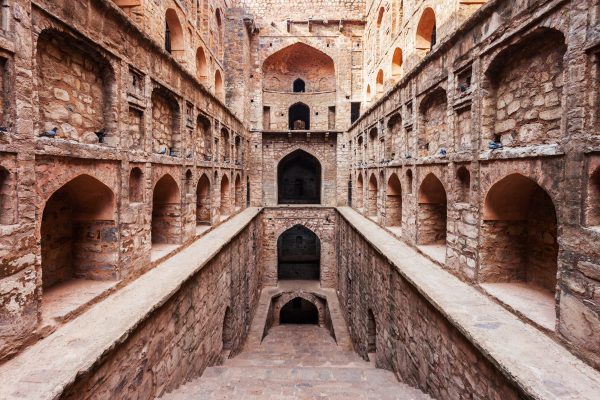
Agrasen Ki Baoli is a hidden gem and a testament to Delhi’s architectural heritage among the city’s Historical Places. This historic stepwell, tucked away amidst the bustling lanes of Connaught Place, is a relic of ancient India, offering a glimpse into the country’s rich history and architectural ingenuity.
Agrasen Ki Baoli is a centuries-old stepwell believed to have been built by the legendary king, Raja Agrasen. This architectural wonder showcases a series of steps leading down to a well, designed to provide access to water even during the driest seasons. The stepwell not only served practical purposes but also held cultural and social significance in ancient times.
History of Agrasen Ki Baoli :
Agrasen Ki Baoli is a historic stepwell located in the heart of Delhi, India. The baoli (stepwell) is believed to have been built during the reign of Maharaja Agrasen, a legendary king of the Agarwal community, although the exact historical origins remain uncertain.
Built By: While the exact builder of Agrasen Ki Baoli is not definitively known, it is attributed to Maharaja Agrasen, who is a revered figure in the Agarwal community.
Built In: The construction of Agrasen Ki Baoli is estimated to date back several centuries, possibly to the 14th century or earlier.
Location
Agrasen Ki Baoli is conveniently located in the heart of Delhi, near Hailey Road, Connaught Place, New Delhi, Delhi 110001, India.
Best Time to Visit
The best time to explore Agrasen Ki Baoli is throughout the year. However, the cooler months from October to March provide a more comfortable environment for visitors to enjoy the surroundings.
Timing
- Agrasen ki Baoli timings are from 7 AM to 6 PM. The opening time of Agrasen Ki Baoli is 7 AM and it is advisable to visit during morning hours.
Entry Fees
- No entry fee is charged to tourists or visitors here.
Nearest Metro Station
The nearest metro station to Agrasen Ki Baoli is “Barakhamba Road Metro Station,” which is part of Delhi Metro’s Blue Line. It’s a short walk from the metro station to the stepwell.
Highlights and Must-See Attractions
- Architectural Symmetry: Agrasen Ki Baoli is known for its impressive architectural symmetry, featuring three levels of arched niches and steps leading down to the water reservoir.
- Haunting Ambiance: The stepwell’s subterranean structure creates an intriguing and somewhat haunting ambiance, making it a popular spot for photography enthusiasts.
- Artistic Details: As you descend the steps, take note of the intricate carvings and architectural details that adorn the walls.
- Cultural and Artistic Events: The Stepwell occasionally hosts cultural events and art exhibitions, making it a dynamic space that combines history with contemporary creativity.
Visitor Tips
- Wear comfortable footwear as you navigate the steps and explore the underground structure.
- Carry drinking water, especially during the hot months, as there are no facilities to purchase refreshments on-site.
- Respect the historical significance of the site by refraining from littering or defacing any of the structures.
- Take your time to explore the stepwell and soak in the historical ambiance. It’s a unique experience that offers a break from the city’s hustle and bustle.
Other Monuments Near Agrasen Ki Baoli :
- Connaught Place: Explore Connaught Place, a bustling commercial and entertainment hub in Delhi, known for its colonial-era architecture and shopping.
- Jantar Mantar: Visit the Jantar Mantar observatory, an astronomical and architectural marvel built by Maharaja Jai Singh II in the 18th century.
- Gurudwara Bangla Sahib: Pay your respects at Gurudwara Bangla Sahib, one of the most prominent Sikh temples in Delhi, known for its serene atmosphere and community kitchen (langar).
- India Gate: Pay homage at India Gate, a war memorial dedicated to Indian soldiers who sacrificed their lives in World War I.
- National Museum: Explore the National Museum, which houses an extensive collection of art, archaeology, and historical artifacts.
- Rashtrapati Bhavan: Admire the grandeur of the Rashtrapati Bhavan, the official residence of the President of India.
- Parliament House: See the iconic Parliament House, an architectural masterpiece that houses the Indian Parliament.
Top Things to Do Nearby Agrasen Ki Baoli :
- Explore the Baoli: Begin your visit by exploring Agrasen Ki Baoli, marveling at its unique architecture and serene ambiance.
- Photography: Capture the stunning architecture and play of light and shadows at Agrasen Ki Baoli, making it a favorite spot for photographers.
- Shopping: Visit the nearby markets, including Connaught Place, for shopping, dining, and entertainment.
- Historical Landmarks: Explore the other historical monuments and landmarks mentioned above to get a well-rounded experience of Delhi’s history and culture.
Agrasen Ki Baoli, Delhi, is a historical treasure that provides a tranquil escape from the urban chaos. It’s not only an architectural marvel but also a reminder of the ingenuity of ancient India. A visit to this stepwell is a journey back in time and a must for anyone exploring Delhi’s Historical Places.
Delhi is filled with many historical places that you absolutely must visit. Let’s take a closer look at some more of these incredible historical places in Delhi, that’s why it is among the Top 10 Historical Places in Delhi.
Also Read: 22 Best Trekking Places in India You Must Do in 2023
8. Jama Masjid, Delhi – Historical Places In Delhi
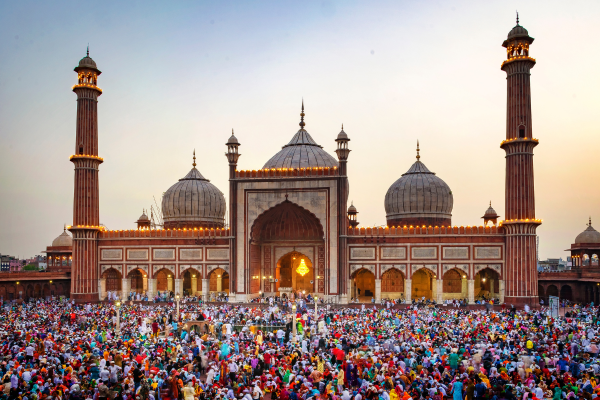
Jama Masjid, a masterpiece of Mughal architecture, is an iconic symbol of faith and heritage among Delhi’s Historical Places. This grand mosque stands as a testament to the architectural and cultural richness of India, drawing visitors from across the globe to admire its splendor.
Jama Masjid, commissioned by the Mughal Emperor Shah Jahan, was completed in 1656. This monumental mosque is known for its grand scale and stunning architectural details. The mosque’s name, “Jama Masjid,” translates to “Friday Mosque,” signifying its significance as a place for congregational Friday prayers.
History of Jama Masjid:
Jama Masjid, also known as the Masjid-i-Jahan-Numa, is one of the largest and most magnificent mosques in India. It holds historical significance as it was built during the Mughal era. The construction of the mosque began in 1650 AD during the reign of Emperor Shah Jahan.
Built By: Jama Masjid was built by Emperor Shah Jahan, who is famous for constructing iconic landmarks such as the Taj Mahal and the Red Fort.
Built In: The construction of Jama Masjid was completed in 1656 AD, taking approximately six years to finish.
Location
Jama Masjid is centrally located in the heart of Old Delhi. You can find it at Meena Bazaar, Jama Masjid, Chandni Chowk, New Delhi, Delhi 110006, India.
Best Time to Visit
The ideal time to explore Jama Masjid is during the cooler months, which typically span from October to March. Visiting during this period ensures a more comfortable experience, as Delhi can get quite hot during the summer.
Timing
- Jama Masjid is open to visitors from Tuesday to Sunday.
- The mosque’s operational hours are from 7:00 AM to 12:00 PM and from 1:30 PM to 6:30 PM.
- It remains closed on Mondays.
Entry Fees
- There is no entry fee to visit Jama Masjid. However, if you plan to use a camera for photography, there may be a nominal fee for a camera permit.
Nearest Metro Station
The nearest metro station to Jama Masjid is “Chandni Chowk Metro Station,” which is part of Delhi Metro’s Yellow Line. From there, it’s a short walk to the mosque.
Highlights and Must-See Attractions
- Architectural Grandeur: Jama Masjid is renowned for its massive central dome, two towering minarets, and intricate red sandstone and marble work. The mosque’s facade is adorned with intricate calligraphy and floral motifs.
- Courtyard: The mosque’s vast courtyard can accommodate thousands of worshippers during prayer times. It’s a serene space to soak in the spiritual atmosphere.
- Climbing the Minarets: Visitors can climb the Minarets for panoramic views of Old Delhi. The ascent involves a steep and narrow staircase, but the view from the top is worth the effort.
- Reflecting Pool: In the courtyard, you’ll find a reflecting pool used for ablutions before prayer.
- Archaeological Museum: The mosque complex also houses an Archaeological Museum that showcases a collection of relics and historical artifacts.
Visitor Tips
- Dress modestly, covering your shoulders and knees, when visiting the mosque out of respect for the religious site.
- Remove your shoes before entering the mosque.
- Visitors may be required to cover their heads before entering the prayer area. Scarves are often available for this purpose.
- Plan your visit to coincide with non-prayer times to explore the mosque freely.
- Be mindful of prayer times and maintain silence during these periods to respect the worshippers.
Other Monuments Near Jama Masjid:
- Red Fort: Explore the nearby Red Fort, a UNESCO World Heritage Site and a symbol of India’s rich history.
- Chandni Chowk: Stroll through Chandni Chowk, one of Delhi’s oldest and busiest markets, known for its vibrant atmosphere and street food.
- Raj Ghat: Pay your respects at Raj Ghat, the memorial dedicated to Mahatma Gandhi, the father of the Indian nation.
- Fatehpuri Masjid: Visit Fatehpuri Masjid, another historic mosque located in the vicinity of Jama Masjid.
- Shri Digambar Jain Lal Mandir: Explore the Shri Digambar Jain Lal Mandir, the oldest Jain temple in Delhi, known for its stunning architecture.
Top Things to Do Nearby Jama Masjid:
- Climb the Minaret: Climb the minaret of Jama Masjid to enjoy panoramic views of Old Delhi.
- Attend Prayer Services: If you’re interested in the Islamic faith, you can attend prayer services at the mosque to experience its spiritual ambiance.
- Photography: Capture the architectural beauty and intricate details of Jama Masjid and its surroundings.
- Shopping: Explore the markets of Chandni Chowk for shopping, where you can find traditional Indian clothing, jewelry, spices, and more.
- Street Food: Savor the delicious street food of Old Delhi, including kebabs, chaat, and jalebi, at the various food stalls and eateries in the area.
- Heritage Walks: Join heritage walks or guided tours to learn about the history and culture of Old Delhi.
Jama Masjid, Delhi, is not just a place of worship; it’s a testament to India’s rich cultural and architectural heritage. Its grandeur and historical significance make it a must-visit among Delhi’s Historical Places, offering visitors a profound connection to the city’s past and present, that’s why it is among the Top 10 Historical Places in Delhi.
9. Hauz Khas (Siri) – Historical Places In Delhi
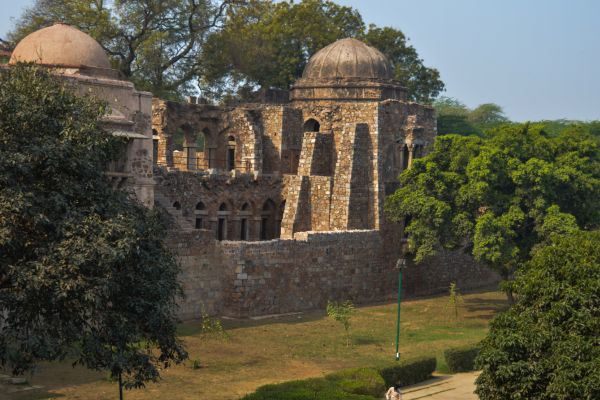
Hauz Khas (Siri) is a historical complex that offers a serene escape from the urban hustle and bustle, making it a hidden gem among Delhi’s Historical Places. Nestled in the heart of South Delhi, this area comprises a historic reservoir, lush greenery, and architectural remnants, making it a perfect blend of history and natural beauty.
It encompasses a historic water tank, which was originally constructed during the reign of Alauddin Khilji in the 13th century. The tank was built to supply water to the Siri Fort, a mediaeval city that once stood in the vicinity. Today, it is a tranquil reservoir surrounded by lush greenery and dotted with historical remnants.
History of Hauz Khas :
Hauz Khas, also known as Hauz Khas Complex or Siri Fort, is a historic area in Delhi, India, with a rich history dating back to the medieval period. It was originally developed during the reign of Ala-ud-din Khilji in the 13th century.
Built By: Hauz Khas was built under the patronage of Sultan Ala-ud-din Khilji, who ordered the construction of a large water reservoir and surrounding structures, making it a prominent center during his time.
Built In: The construction of the Hauz Khas complex began in the early 13th century and continued over several years during the rule of Ala-ud-din Khilji and his successors.
Location
Hauz Khas (Siri) is located in South Delhi, near Hauz Khas Village. The precise address is Hauz Khas Tank, Hauz Khas, New Delhi, Delhi 110016, India.
Best Time to Visit
The best time to explore Hauz Khas (Siri) is during the cooler months, which span from October to March. This period offers pleasant weather for outdoor exploration and enjoying the picturesque surroundings.
Timing
Hauz Khas (Siri) is open to visitors throughout the day. However, it’s advisable to visit during daylight hours to fully appreciate the natural beauty and historical elements.
Entry Fees
- There are no entry fees to access Hauz Khas (Siri). It’s open to the public free of charge.
Nearest Metro Station
The nearest metro station to Hauz Khas (Siri) is “Hauz Khas Metro Station,” which is part of Delhi Metro’s Yellow Line. From there, it’s a short walk to the historical complex.
Highlights and Must-See Attractions
- Hauz Khas Lake: The heart of Hauz Khas (Siri) is a serene lake, which attracts migratory birds and provides a peaceful environment for visitors to relax and unwind.
- Architectural Remnants: The area around the lake is adorned with historical architectural remnants, including a tomb and pavilions that date back to the medieval period.
- Flora and Fauna: The surrounding Deer Park is home to a variety of flora and fauna, making it a popular spot for nature enthusiasts and birdwatchers.
- Art and Culture: Hauz Khas Village, located nearby, is known for its artistic and cultural ambiance. It boasts art galleries, boutiques, cafes, and a vibrant nightlife.
Visitor Tips
- Wear comfortable footwear, as the area includes pathways and green spaces suitable for exploration.
- Carry drinking water and snacks, especially if you plan to spend an extended period enjoying the natural beauty.
- Hauz Khas Village offers a range of dining options, making it a great place to enjoy a meal after exploring Hauz Khas (Siri).
- Respect the natural surroundings and historical elements by refraining from littering or defacing any structures.
- Keep an eye out for local events and cultural performances that occasionally take place in the area.
Other Monuments Near Hauz Khas:
- Siri Fort: The Siri Fort, also known as the Siri Complex, is a historic fortification and the second city of Delhi built by Ala-ud-din Khilji. It is located adjacent to Hauz Khas.
- Deer Park: The Deer Park, a serene and green area, is located nearby and offers a pleasant escape from the hustle and bustle of the city. It is home to a variety of wildlife, including deer.
- Hauz Khas Village: The modern Hauz Khas Village is a popular hangout spot with a range of restaurants, cafes, boutiques, and art galleries. It offers a blend of history and contemporary culture.
- Tomb of Feroz Shah Tughlaq: Located within the complex, the tomb of Feroz Shah Tughlaq, a 14th-century ruler, is another historical monument to explore.
Top Things to Do Nearby Hauz Khas (Siri):
- Explore the Hauz Khas Complex: Visit the historic Hauz Khas Complex, which includes the water reservoir, tombs, madrasa ruins, and beautiful gardens.
- Deer Park: Enjoy a leisurely walk or picnic at the Deer Park, where you can spot deer and other wildlife.
- Hauz Khas Village: Explore the vibrant Hauz Khas Village, known for its trendy cafes, restaurants, and boutiques. It’s a great place for shopping, dining, and art appreciation.
- Siri Fort Auditorium: Check out cultural events and performances at the Siri Fort Auditorium, which hosts various artistic and theatrical productions.
- Photography: Capture the picturesque landscapes and historical architecture in and around Hauz Khas for memorable photographs.
- Learn About History: Explore the historical significance of the Hauz Khas Complex and Siri Fort by reading informative plaques and signs on-site.
Hauz Khas (Siri) is a peaceful haven that seamlessly combines history, nature, and contemporary culture. It offers a serene escape from the city’s chaos and is a must-visit among Delhi’s Historical Places, allowing visitors to connect with both the past and the present in a tranquil setting, that’s why it is among the Top 10 Historical Places in Delhi.
10. Jantar Mantar – Historical Places In Delhi
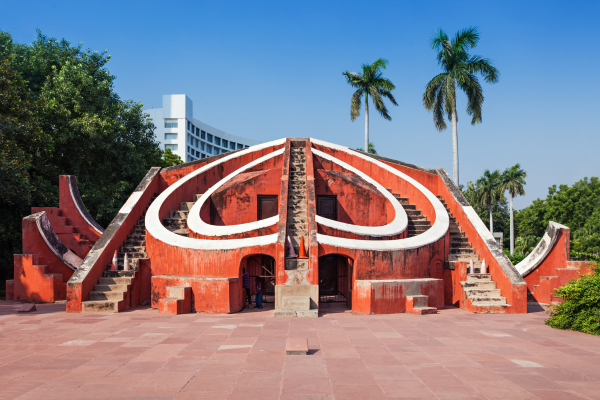
Jantar Mantar, constructed in the 18th century by Maharaja Jai Singh II of Jaipur, is a collection of architectural astronomical instruments. These instruments were used to measure time, track celestial objects, and predict eclipses with astonishing accuracy. The term “Jantar Mantar” translates to “calculation instrument,” underscoring the observatory’s purpose
Jantar Mantar is a historic observatory that stands as a remarkable testament to India’s astronomical prowess and mathematical ingenuity. Among Delhi’s Historical Places, it is a place where science and history seamlessly converge, offering visitors a unique opportunity to explore the celestial world.
History of Jantar Mantar:
Jantar Mantar is an astronomical observatory located in Delhi, India. It was built during the 18th century by Maharaja Jai Singh II of Jaipur, a renowned astronomer and ruler of the region. Jantar Mantar was constructed with the primary purpose of observing and recording celestial phenomena.
Built By: Jantar Mantar was built by Maharaja Jai Singh II, who was a patron of the sciences and had a keen interest in astronomy and mathematics.
Built In: The construction of Jantar Mantar in Delhi was completed in 1724. It was one of several such observatories built by Maharaja Jai Singh II in different parts of India, including Jaipur, Ujjain, Mathura, and Varanasi.
Location
Jantar Mantar is conveniently located in the heart of New Delhi, near Connaught Place. The precise address is Sansad Marg, Connaught Place, New Delhi, Delhi 110001, India.
Best Time to Visit
The best time to visit Jantar Mantar is during the cooler months, which typically span from October to March. This period offers a more comfortable climate for outdoor exploration.
Timing
Jantar Mantar is open to visitors from Tuesday to Sunday. The observatory’s operational hours are from 9:30 AM to 4:30 PM. It remains closed on Mondays.
Entry Fees
The entry fees for Jantar Mantar are as follows:
- For Indian citizens: INR 5 per person.
- For foreign tourists: INR 100 per person.
- Free for children under the age of 15.
Nearest Metro Station
The nearest metro station to Jantar Mantar is “Patel Chowk Metro Station,” which is part of Delhi Metro’s Yellow Line. It’s a short walk from the metro station to the observatory..
Highlights and Must-See Attractions
- Astronomical Instruments: The observatory houses a series of massive and intricately designed instruments, including the Samrat Yantra (giant sundial), Jai Prakash Yantra (equatorial sundial), and Ram Yantra (cylindrical instrument).
- Samrat Yantra: The Samrat Yantra is the largest sundial in the world and can accurately measure time to within two seconds.
- Jai Prakash Yantra: This sundial allows for the precise measurement of celestial altitudes and azimuths.
- Ram Yantra: The Ram Yantra is a cylindrical instrument used for measuring the altitude and azimuth of celestial objects.
- Rama Yantra: This instrument is used to measure the altitude of stars and planets.
- Misra Yantra: The Misra Yantra is a unique instrument with multiple uses, including tracking the position of celestial objects and predicting eclipses.
Visitor Tips
- Wear comfortable footwear suitable for exploring the outdoor observatory.
- Carry drinking water and sunscreen, especially during sunny days, as there is limited shade.
- Bring a camera to capture the intricate details of the astronomical instruments and the historical ambiance.
- Consider hiring a guide to gain a deeper understanding of the observatory’s significance and functionality.
- Be mindful of the historical importance of the site and refrain from touching or climbing on the instruments.
Other Monuments Near Jantar Mantar:
- Connaught Place: Explore Connaught Place, a bustling commercial and entertainment hub in Delhi, known for its colonial-era architecture and shopping.
- India Gate: Pay your respects at India Gate, a prominent war memorial dedicated to Indian soldiers who died in World War I.
- Rashtrapati Bhavan: Admire the grandeur of Rashtrapati Bhavan, the official residence of the President of India.
- Parliament House: See the iconic Parliament House, an architectural masterpiece that houses the Indian Parliament.
- Gurudwara Bangla Sahib: Visit Gurudwara Bangla Sahib, one of the most prominent Sikh temples in Delhi, known for its serene atmosphere and community kitchen (langar).
Top Things to do Nearby Jantar Mantar:
- Explore Jantar Mantar: Take a guided tour or explore the various astronomical instruments at Jantar Mantar, which were used for precise celestial observations.
- Photography: Capture the unique and striking architectural features of Jantar Mantar, making it a favorite spot for photographers.
- Learn About Astronomy: Discover the history of astronomy in India and the significance of the instruments at Jantar Mantar.
- Visit Nearby Landmarks: Explore the other historical monuments and landmarks mentioned above to get a well-rounded experience of Delhi’s history and culture.
Jantar Mantar, Delhi, is a living testament to India’s scientific heritage and a must-visit among Delhi’s Historical Places. It offers a unique window into the world of astronomy and mathematics, where ancient wisdom meets modern curiosity.
A visit to this site is a journey through time and an appreciation of human achievement in the realm of science and technology, that’s why it is among the Top 10 Historical Places in Delhi.
Delhi has some incredible historical places that are like time machines, taking you back to different periods in India’s history. These top 10 spots are not just old buildings; they’re windows into the past.
Whether you’re a history enthusiast or just someone curious about the past, Delhi’s historical sites are like hidden treasures waiting to be discovered.
They show off amazing architecture, art, and the mix of cultures that have shaped Delhi over the years. Visiting these places is like taking a journey through history, and they remind us of the fascinating stories that make up the city’s rich heritage.
So, if you’re ever in Delhi, make sure to explore these historical gems – they’re a must-see!
